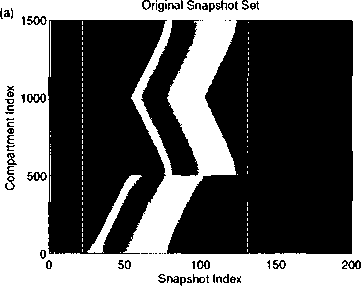78


Figure 3.3: Illustration of Branch-Ortho with routes on a forked neuron, (a) The original
set of snapshots, with white dashed lines bounding the global active zone obtained via the
first application of V-Slim. (b) The resulting snapshot set after the Branch-Ortho algorithm
is run. Two routes are used: one consisting of branches 1 and 3, and one of just branch 2.
Notice that information about the coupling at the junction is preserved in the first route.
White dashed lines in this plot enclose the snapshots to be removed, as computed via the
second V-Slim application.
and the length of a route is the sum of the lengths of the branches it contains,
i.e. Ien(R) - ∑bef√b.
Routes are useful because if we are given a set of snapshots in which an action
potential travels from the soma throughout the dendritic tree, then routes form long,
continuous snapshots of the dynamics and maintain coupling information between
parents and children (see Figure 3.3). Not only does using routes improve accuracy,
but it further shrinks the size of the snapshot set. Since the active zones of the parent
and child branches overlap, routes yield more information in fewer snapshots than the
naïve method.
Which routes should comprise the Branch-Ortho snapshot set? Let 77 denote a
set of routes and let dim (77) be defined as the number of routes in the set. We define
77 to be optimal if
More intriguing information
1. The name is absent2. Valuing Farm Financial Information
3. Creating a 2000 IES-LFS Database in Stata
4. Investment in Next Generation Networks and the Role of Regulation: A Real Option Approach
5. Income Mobility of Owners of Small Businesses when Boundaries between Occupations are Vague
6. The name is absent
7. Emissions Trading, Electricity Industry Restructuring and Investment in Pollution Abatement
8. Impact of Ethanol Production on U.S. and Regional Gasoline Prices and On the Profitability of U.S. Oil Refinery Industry
9. Firm Creation, Firm Evolution and Clusters in Chile’s Dynamic Wine Sector: Evidence from the Colchagua and Casablanca Regions
10. Skill and work experience in the European knowledge economy